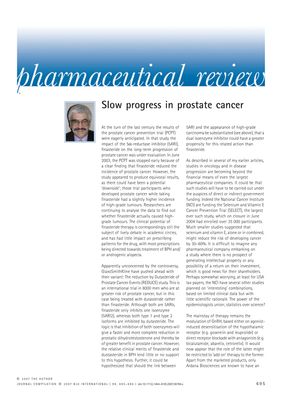Slow Progress in Prostate Cancer
February 2007
in “
BJUI
”

TLDR Finasteride reduces prostate cancer risk but may increase high-grade tumors; new drugs and better diagnosis are in development, but funding and industry commitment are challenges.
In 2003, the Prostate Cancer Prevention Trial (PCPT) was stopped early due to findings that finasteride, a 5α-reductase inhibitor (5ARI), reduced the incidence of prostate cancer. However, there was concern because participants who developed prostate cancer while on finasteride had a higher incidence of high-grade tumors, leading to ongoing analysis and debate about finasteride's role in potentially causing these tumors. Despite this, GlaxoSmithKline proceeded with the REDUCE study, involving 8,000 men at higher risk for prostate cancer, using dutasteride, which inhibits both type 1 and type 2 5α-reductase isoenzymes, unlike finasteride which only inhibits one. The document also discusses the financial challenges of conducting large oncology studies, suggesting that government funding may be necessary, as seen with the Selenium and Vitamin E Cancer Prevention Trial (SELECT) involving over 35,000 participants. Current therapies for prostate cancer focus on modulating GnRH, with drugs like goserelin and leuprolide, and the potential for 'add on' therapy with antagonists like bicalutamide. Ardana Biosciences is evaluating the GnRH antagonist teverelix, which has shown promising Phase II results. The document also mentions selective androgen receptor modulators (SARMs) in development and the potential for more precise early-stage diagnosis to improve treatment outcomes. However, there is skepticism about the pharmaceutical industry's commitment to developing new drug classes for prostate cancer, with improved diagnosis seen as more likely to advance treatment and prevention.





